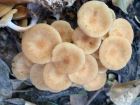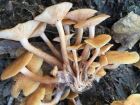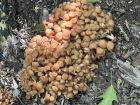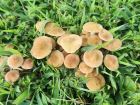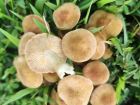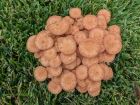Cap varies in colour from ochraceous to tawny and dark brown (sometimes yellow to yellowish), when young covered with darker fibrous scales that are at maturity more concentrated toward the centre. It is initially convex, then flattens, becoming wavy and shallowly funnel-shaped. The flesh is white, thin and firm. Gills run down the stem or nearly so and are close or slightly more spaced. Short gills are frequent. They are whitish with pinkish hints. Stem tapers toward the base. It is smooth and pale greyish to brownish near the top, becoming darker brown and almost hairy lower down. There is no ring. Spore print white.
Microscopic Features: The spores are ellipsoidal, smooth, and measure 8–10 by 5–7 µm. They are amyloid.
Synonyms: Desarmillaria tabescens, Armillaria tabescens, and Desarmillaria caespitosa are the same species.
Desarmillaria tabescens on the First Nature Web site.
Armillaria tabescens on the MushroomExpert.Com Web site.
Many mushrooms are poisonous, and some can be lethally toxic. Distinguishing between edible and poisonous mushrooms can be very challenging. Therefore, we strongly advise against consuming wild mushrooms. This website does not contain any information about the edibility or toxicity of mushrooms.
Although efforts have been made to ensure accuracy on this website, the information may contain errors and omissions. Therefore, all content provided is for educational and informational purposes only and should not be relied upon or used as a basis for consuming any plants or mushrooms.
External links are provided for reference only. We do not endorse or take responsibility for the content, advice, or products found on these sites or in any advertisements shown on this website.
